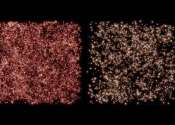Neutrinos put cosmic ray theory on ice
(Phys.org) -- A telescope buried beneath the South Pole has failed to find any neutrinos accompanying exploding fireballs in space, undermining a leading theory of how cosmic rays are born.

(Phys.org) -- A telescope buried beneath the South Pole has failed to find any neutrinos accompanying exploding fireballs in space, undermining a leading theory of how cosmic rays are born.
Astronomy
Apr 20, 2012
11
0

A team of scientists has predicted the science return from one of NASA's Nancy Grace Roman Space Telescope's groundbreaking planned surveys, which will analyze millions of galaxies strewn across space and time. The mission's ...
Astronomy
Mar 22, 2022
0
482

Space is cold, dark, and lonely. Deadly, too, if any one of a million things goes wrong on your spaceship. It's certainly no place for a computer chip to fail, which can happen due to the abundance of radiation bombarding ...
General Physics
Sep 7, 2015
4
99

We all know bubbles from soapy baths or sodas. These bubbles of everyday experience on Earth are up to a few inches across, and consist of a thin film of liquid enclosing a small volume of air or other gas. In space, however, ...
Astronomy
Feb 28, 2019
4
247

High-energy bursts of gamma rays typically occur far out in space, perhaps near black holes or other high-energy cosmic phenomena. So imagine scientists' surprise in the mid-1990s when they found these powerful gamma ray ...
Space Exploration
Feb 2, 2010
2
0

A constant shower of subatomic particles rains down from space. A hundred years ago, this "cosmic radiation" was discovered by the Austrian physicist Victor Franz Hess. Among other things, the discovery laid the foundation ...
General Physics
Jul 31, 2012
0
0

With the Cherenkov Telescope Array (CTA) that is currently under construction, researchers hope to observe highly energetic gamma rays that could lead to the discovery of new objects in and outside of our galaxy and even ...
Astronomy
Aug 24, 2020
0
467

The discovery of a pattern of X-ray "stripes" in the remains of an exploded star may provide the first direct evidence that a cosmic event can accelerate particles to energies a hundred times higher than achieved by the most ...
Astronomy
Mar 24, 2011
7
0

(PhysOrg.com) -- ESA's Cluster satellites have discovered that cosmic particle accelerators are more efficient than previously thought. The discovery has revealed the initial stages of acceleration for the first time, a process ...
Astronomy
Nov 17, 2011
0
0

When massive stars or other stellar objects explode in the Earth's cosmic neighborhood, ejected debris can also reach our solar system. Traces of such events are found on Earth or the moon and can be detected using accelerator ...
Astronomy
Nov 2, 2023
0
73